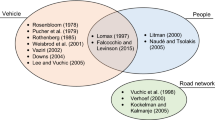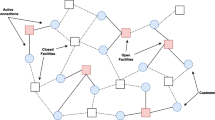Abstract
Disruption of network facilities (nodes or arcs) resulting in loss of system functionality is of particular concern in the operation of critical network infrastructures. In preparing for events such as natural disasters, accidents, and/or sabotage, numerous disruption possibilities exist for any network and efforts to safeguard against the most destructive of those are often sought. Although, many approaches exist for identifying network vulnerabilities, mathematical programming and simulation are typically used as exploratory approaches for uncovering potentially important disruption scenarios. Mathematical programming approaches can identify bounds on network vulnerability while simulation can provide important insights to complement these bounds, as well as provide insights in cases where mathematical programming is not practical. This research presents a simulation methodology for evaluating network vulnerability to disruption. A case study illustrates the complexities associated with planning for such events.
Similar content being viewed by others
References
Abilene (2005) http://abilene.internet2.edu/
Church RL, Scaparra MP, Middleton RS (2004) Identifying critical infrastructure: the median and covering facility interdiction problems. Ann Assoc Am Geogr 94(3): 491–502
Grubesic TH, Matisziw TC, Murray AT, Snediker D (2008) Comparative approaches for assessing network vulnerability. Int Reg Sci Rev 31(1): 88–112
Grubesic TH, O’Kelly ME, Murray AT (2003) A Geographic perspective on commercial internet survivability. Telematics Informatics 20(1): 51–69
Israeli E, Wood RK (2002) Shortest-path network interdiction. Networks 40(2): 97–111
Jenelius E, Petersen T, Mattsson L-G (2005) Importance and exposure in road network vulnerability analysis. Transport Res Part A 40: 537–560
Matisziw TC, Murray AT (2008) Modeling s–t path availability to support disaster ulnerability assessment of network infrastructure. Comput Oper Res (in press.) doi:10.1016/j.cor.2007.09.004
Murray AT, Matisziw TC, Grubesic TH (2008) Multimethodological approaches to network vulnerability analysis. Growth Change (in press)
Murray AT, Matisziw TC, Grubesic TH (2007) Critical network infrastructure analysis: interdiction and system flow. J Geogr Syst 9: 103–117
Ratliff DH, Sicilia GT, Lubore SH (1975) Finding the n most vital links in flow networks. Manage Sci 21(5): 531–539
Salmeron J, Wood K, Baldick R (2004) Analysis of electric grid security under terrorist threat. IEEE Trans Power Syst 19(2): 905–912
Wood KR (1993) Deterministic network interdiction. Math Comp Model 17(2): 1–18
Author information
Authors and Affiliations
Rights and permissions
About this article
Cite this article
Matisziw, T.C., Murray, A.T. & Grubesic, T.H. Exploring the vulnerability of network infrastructure to disruption. Ann Reg Sci 43, 307–321 (2009). https://doi.org/10.1007/s00168-008-0235-x
Received:
Accepted:
Published:
Issue Date:
DOI: https://doi.org/10.1007/s00168-008-0235-x




